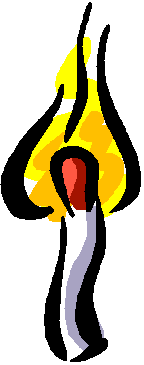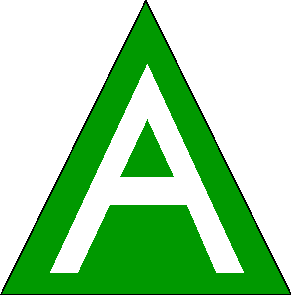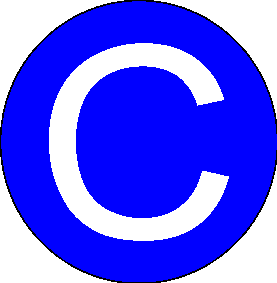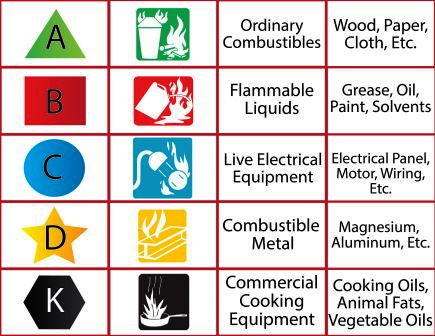|
Home
Directory
Guardian III -
Fire Suppression System
Cooking Fire Safety
Information/Edu
Prevention
Emergency Prep
Equipment
Fire Extinguishers
Alarms
Safety Links
FAQ's
Your Hosts
Feedback
|
|
Portable Fire Extinguishers
|
Defining
fire.
|
Firefighters are
taught that fire is the rapid oxidation of a fuel with the evolution of
heat and light (?) As soon as they learn what it is, they are taught how
to put it out. It's a shame that more emphasis is not put on
preventing the fire from happening ! (Dave's pet peeve). Anyway, 4 things
need to happen just right to make fire; a fuel must combine with a heat
source in enough air to begin off-gassing; then, a chemical chain reaction
begins, and the gas is ignited by the heat.
 +
+
 +O2 = +O2 =

Translation:
most things that burn need oxygen and a heat source before fire
occurs. Further translation: keep the fuels away from the heat
sources, wherever possible, and you too can prevent fires from occurring.

|
| Types of fire.
|
There are 4
types of fire commonly seen, and 1 type rarely seen--but possible, in your
daily life. These types are indicative of the fuel types or fire causes.
 Class "A"
fires involve ordinary combustible material as fuel (most common), such
as: wood, paper, plastic, rubber, and cloth. The international
pictogram is a green triangle with an A inside. Class "A"
fires involve ordinary combustible material as fuel (most common), such
as: wood, paper, plastic, rubber, and cloth. The international
pictogram is a green triangle with an A inside.
 Class "B"
fires involve flammable liquids and gases, exclusively. The international
pictogram is a red square with a B inside.
Class "B"
fires involve flammable liquids and gases, exclusively. The international
pictogram is a red square with a B inside.
 Class "C" fires involve energized electrical equipment. When the
electricity is cut off, these fires are then treated as a Class A or B
type. The international pictogram is a blue circle with a C inside.
Class "C" fires involve energized electrical equipment. When the
electricity is cut off, these fires are then treated as a Class A or B
type. The international pictogram is a blue circle with a C inside.
 Class "D"
fires involve combustible metals. These aren't seen very often, but
sometimes these metals are used in automobile and machine manufacturing
and construction. The international pictogram is a yellow star with a D
inside.
Class "D"
fires involve combustible metals. These aren't seen very often, but
sometimes these metals are used in automobile and machine manufacturing
and construction. The international pictogram is a yellow star with a D
inside.
Class
"K"
fires involve a liquid cooking medium (oil or grease).


|
| Types of fire
extinguishers. |
The most
common portable fire extinguisher is the "dry chemical"
"stored-pressure" type. This type contains a very dry, specially
formulated chemical or powder that is meant to interrupt the chemical
chain reaction necessary for flame development--so the fire goes out ! Dry
chemical fire extinguishers are made for each type of fire. You must
anticipate the potential hazard(s) and be sure to match the type of fire
extinguisher with the type of fire that might occur. A 5 to 6 pound dry
chemical extinguisher is rated at 2 or 3A:40B:C.
There are also
specially formulated "wet chemical", stored-pressure fire
extinguishers that work in about the same way. They also provide a limited
"cooling" and "smothering" effect. Most wet chemical fire extinguishers
are rated from 40B:C and higher. A very effective hybrid portable is the foam type. This extinguisher is good for Class A, B, & C fires. A
2-liter foam extinguisher is rated at 8A; 70B; C. The 6-liter Class K
extinguisher, for cooking mediums, is a wet chemical type.
There are
also stored-pressure water fire extinguishers. Each one carries 2.5
gallons of water, and some have special additives to keep them from
freezing or to make them more effective. Without additives, the water
extinguisher is 2A-rated.
Stored-pressure
fire extinguishers are immediately ready to use--they have the
expellant means already inside the shell (canister). This is usually a
charge of (inert) Nitrogen gas.
Non-stored-pressure
fire extinguishers do not have their agent under pressure, but carry the
pressurizing cylinder on the side. This type must be pressurized before it
can be used.

|
|
Fire
extinguisher rating system. |
The
rating system for portable fire extinguishers can be very confusing. It is
based on the types of fire, i.e., A:B:C:D:or K. When testing began long
ago, labs used a 3'x3'x3' "crib" of loosely stacked wood. If a fire
extinguisher and a trained operator could extinguish this crib of wood
when fully involved with fire, it received a 1A rating. To visualize
higher ratings, just multiply the volume of the "cribbed" wood stack. A 5
to 6 pound dry chemical extinguisher is rated at 2 or 3A depending on its
chemical mixture. All other things being equal, a 4A rated extinguisher
should be able to extinguish twice as much fire as a 2A rated
extinguisher. Remember: this is in a lab with a trained operator !
The standard rating
for flammable and combustible liquids is 1 square foot of surface area of
a "pooled" liquid at an appreciable depth (1/4" or more). Liquids will
always seek a lower place, so they will always attempt to "pool" and
therefore contain themselves. Liquids that are unconfined pose a greater
risk, and are referred to as "three-dimensional" spills. The rating for
one unit (1'x1') is 1B. The smallest B:C type extinguishers (2 to 3 lb.)
have a 5 to 10B rating. All other things being equal, an extinguisher
rated 40B should be twice as effective as one rated 20B.
There is no
standard rating for Class C and Class D fires. When a Class C fire is
de-energized, it is treated as a Class A or B type.
Class D fires burn
ferociously, they may burn in the absence of air, and they are highly
reactive to water. These fires must be completely covered with a
compatible agent to at least 1/4" to 1/2", or more.
Class K fire
extinguishers (6-liter) are rated 2A:1B:C:K. Although this doesn't seem
like a lot, these extinguishers are specially formulated to be compatible
with most commercial restaurant hood fire suppression systems, and they
can certainly be used at home. They offer easier clean-up and less
down-time after use.

|
| When to use
portable fire extinguishers. |
A common
misconception is that the primary purpose of portable fire extinguishers
is to put out small fires before they get bigger. While that is surely a
secondary purpose, you should select them, place them, and maintain them
as if your life depended on them ! The primary purpose of a fire
extinguisher should be for life safety--for your protection during an
emergency escape.
To stop a small
fire from getting bigger, a portable fire extinguisher should still only
be used under certain circumstances:
~
The fire is small and not developing quickly.
~
The user knows how and is comfortable with using the extinguisher.
~
The material involved
in the fire is known and not hazardous.
~
The extinguisher is compatible with the fuel that is involved.
~
The area of the fire is not already filled with heat and smoke.
~
The user needs no personal protective equipment.
~
The way out is not blocked in any way.
The fire
department should always be called first, if possible !
If all of these
conditions are not present, it probably will not be safe for you to fight
the fire alone. CALL THE PROFESSIONALS
!

|
| How to use
portable fire extinguishers. |
Remember
to PASS !
Pull - the safety pin;
Aim - the nozzle or
hose at the base of the fire;
Squeeze - the lever to
release the agent;
Sweep - the agent from
side-to-side at the base of the fire.
|
| Matching the
extinguisher with the hazard. |
Using a
portable fire extinguisher that is compatible with the type of fire you
have can be very important to your safety and to the results of the
application. The rating system indicates which type (single-purpose) or
types (multi-purpose) of fire a particular extinguisher can effectively be
used.
|
| Reading the
label. |
Reading
the manufacturer's label on a portable fire extinguisher is vitally
important. Everything you need to know can be found there. Look for the
type of fire it is compatible with, the relative effectiveness rating, the
type of agent that is inside, operating and maintenance instructions, and
approvals of credible testing laboratories, such as Underwriter's
Laboratories (UL).
 |
| Proper mounting
is important. |
The proper
placement of your portable fire extinguisher is very important. You want
it near the fire hazard, but not too close. You want it to be nearby, but
also on the way out of the room, area, or house where it is strategically
located. Don't cover them up or allow them to be used as a coat rack !
Extinguishers should always be within sight and ready to use at all
times--when you need them, there will be no time to waste trying to gain
access to this life saving device.
|
| Proper
maintenance is essential. |
Proper
maintenance of your portable fire extinguisher is essential to your piece
of mind, and it ensures that the extinguisher will function properly when
you need it most. Each manufacturer puts recharge and maintenance
information on the label, which is affixed to the extinguisher. Generally,
all aluminum and steel shell, stored-pressure extinguishers must be
inspected at least annually, maintained every six years beginning with the
date of manufacture, and hydro-statically tested and maintained every 12
years beginning with the date of manufacture.
In
residential use, the owners can perform inspections. A specialty
contractor must be used to perform the maintenance and hydro-test. In
commercial use, all inspections, testing, and maintenance must be
performed by a "qualified" contractor (and they are not created equally
!). Inspections can and should be performed monthly, and in places of
employment this is required by OSHA.
Inspections
are non-invasive, and consist of looking at extinguishers to see that they
are where they should be, that they have not been damaged or used, and
that they appear to have adequate pressure by some indicator (most
commonly a gauge).
Maintenance
includes a discharge of the agent, disassembly, cleaning, reassembly, and
pressurization. This constitutes a full functional test.
A hydrostatic
test assures the integrity of the shell or canister of the extinguisher.
The shell is emptied and filled with water, and then pumped to double the
working pressure of the extinguisher--usually 200~400 psi. If the shell
does not burst (rarely ever happens), it is dried and "maintenance" is
performed.

|
| Making your
selection.
|
Now that you
know a little more about portable fire extinguishers, it's time to make
your selection. How many do you need, of what type and size should they
be, and where is the best place to put them in your dwelling or business ?
Generally speaking,
you need one or more for life safety and protection of property and one
for each special hazard you may have. They should also be in every
"compartment" of your dwelling--this is defined by locked doors or floor
levels.
To simplify the
process, you should have one minimum 2-A rated extinguisher that is easily
accessible on each occupied floor level of your dwelling. To minimize size
and weight, this is best accomplished by installing a 5-lb (or larger),
A:B:C rated, multi-purpose, dry chemical type of extinguisher or 2-liter
foam type. The 2.5 gallon water extinguisher meets this minimum, but is
larger and heavier. The 6-liter Class K wet chemical extinguisher also
carries a 2-A rating. The advantage of water, foam, and wet chemical
extinguishers is less mess and easier clean-up after using them.
In addition to
this, you should have a minimum 10-B:C rated (or larger) dry chemical
extinguisher in the kitchen (but not too close to the stove), however the
best choice may be the 2-liter foam type. A Class K wet chemical
extinguisher would be larger and heavier, but also much more effective.
The foam and wet chemical types would definitely be easier to clean-up
after use. An A:B:C-rated multi-purpose dry chemical extinguisher in the
2.5 to 5 pound size would also be small and effective.
You should also
place minimum 2A:40B:C rated (or larger) extinguishers in the garage,
workshop, barn, or other out-buildings. This can be accomplished with a
5-lb or larger multi-purpose dry chemical type extinguisher or the 2-liter
foam type. The farther away help is, the more protection you may need.
Also, as a general
rule, having more of the right sized extinguishers can be more beneficial
and less expensive than having fewer and larger extinguishers.

|
|
.jpeg)